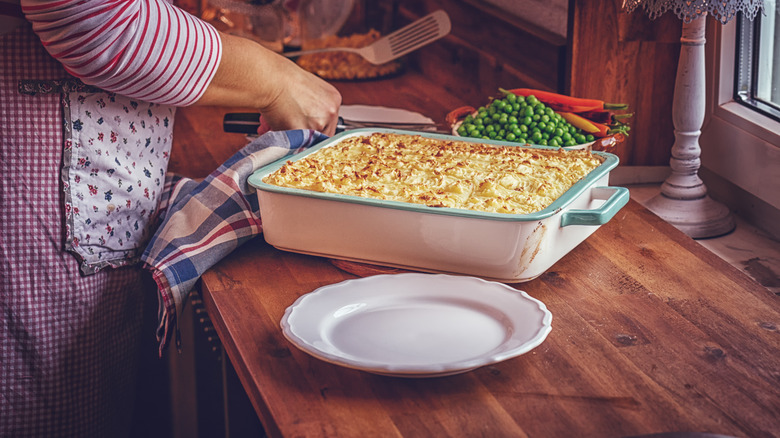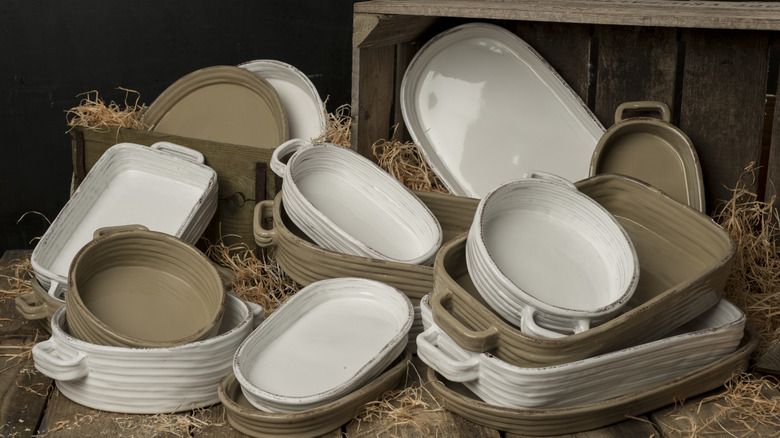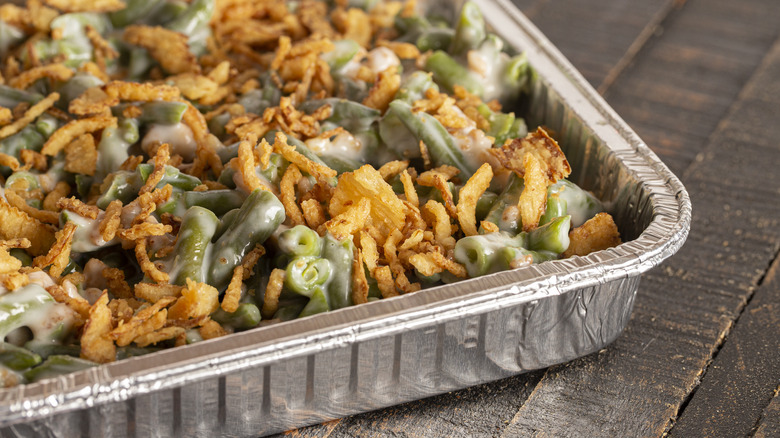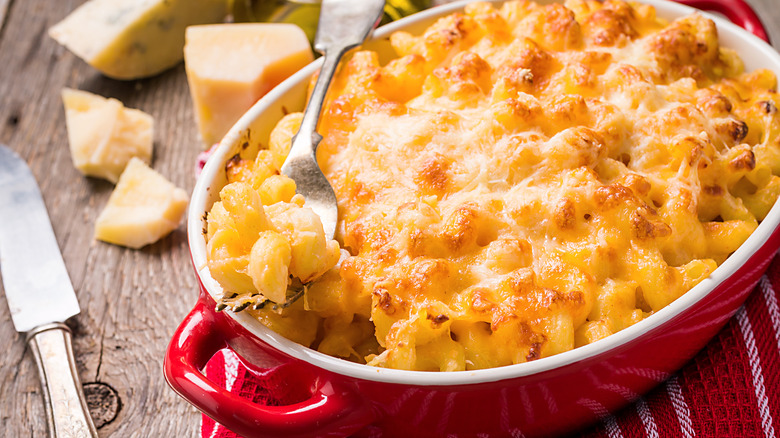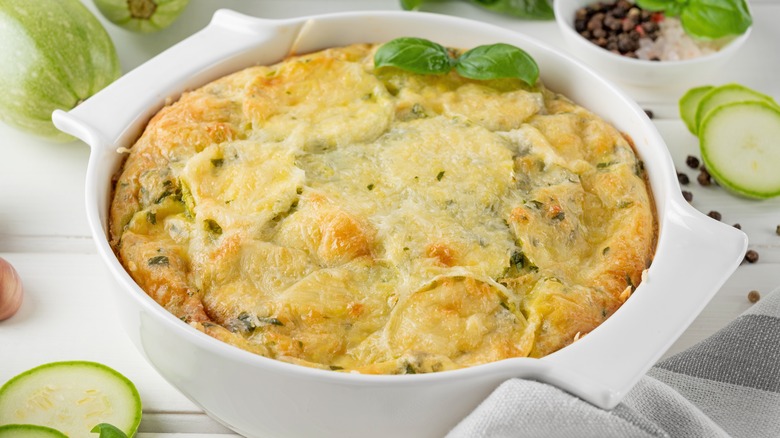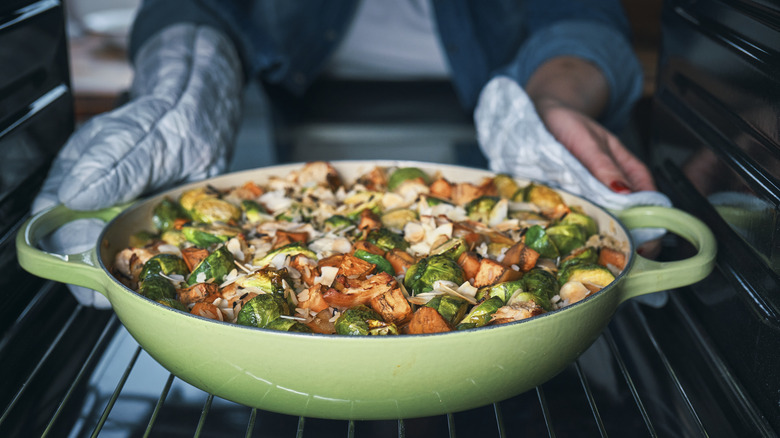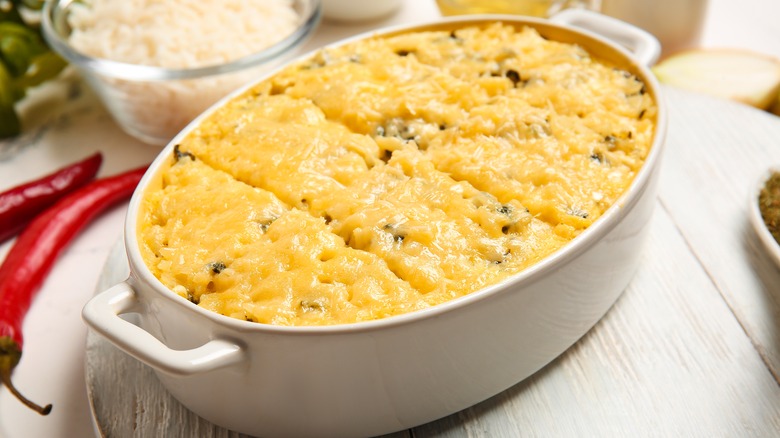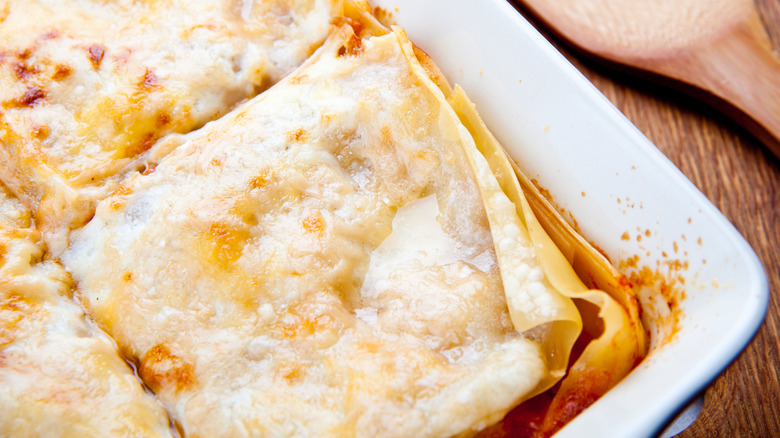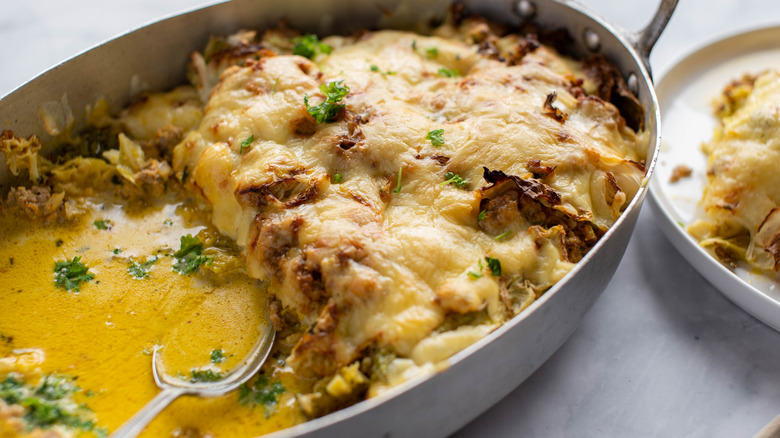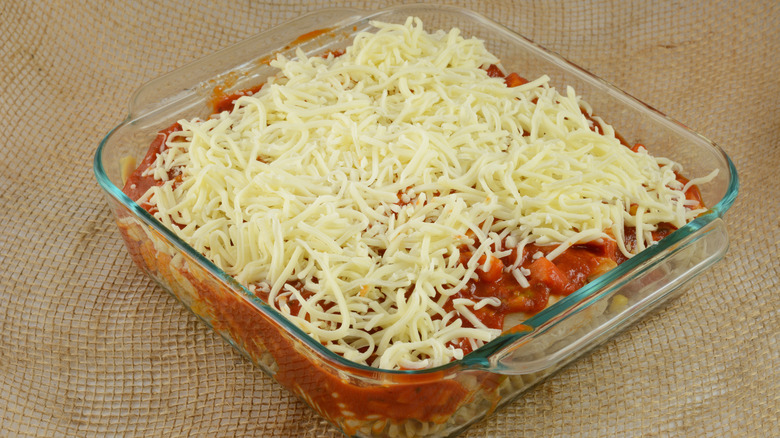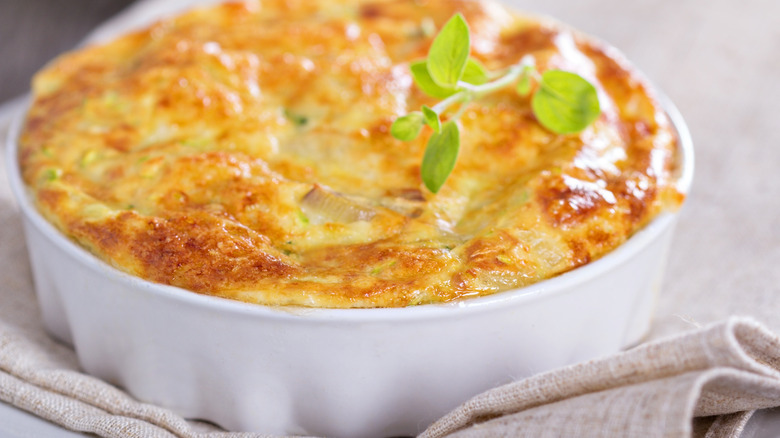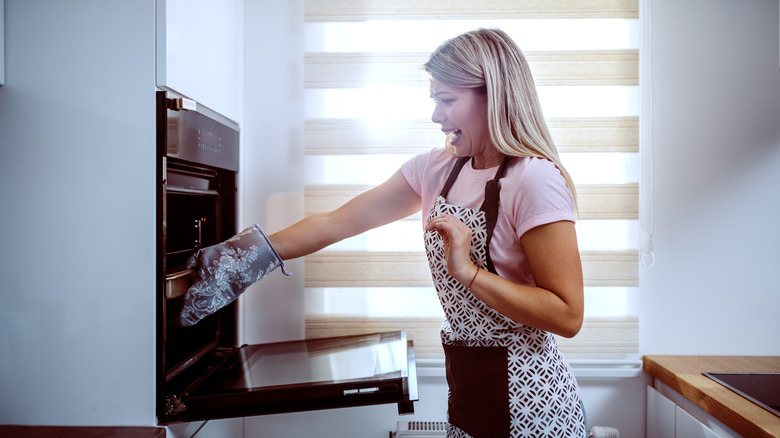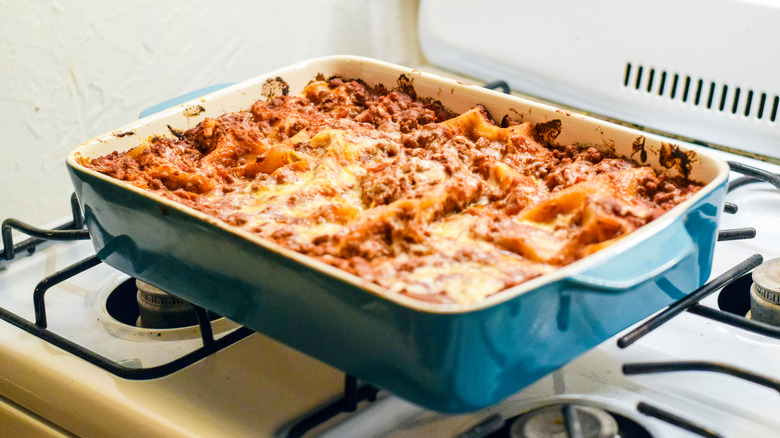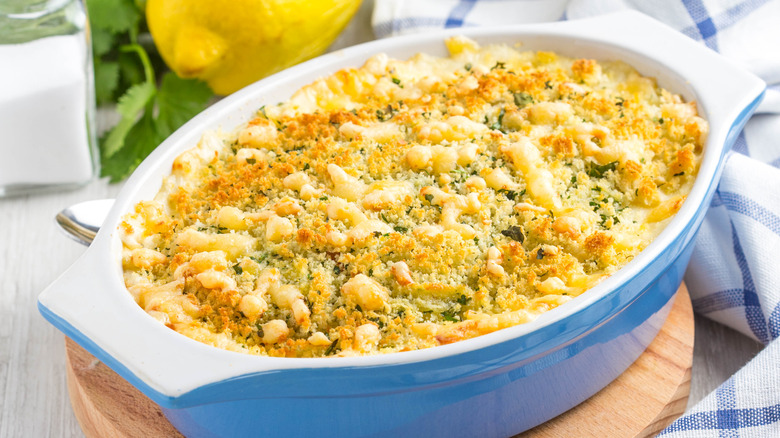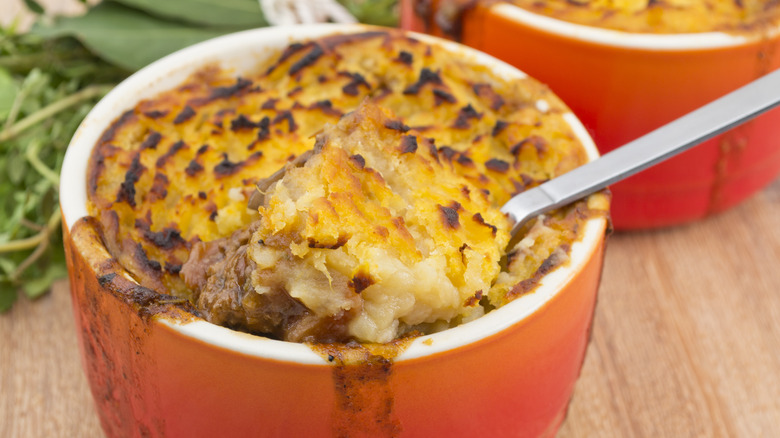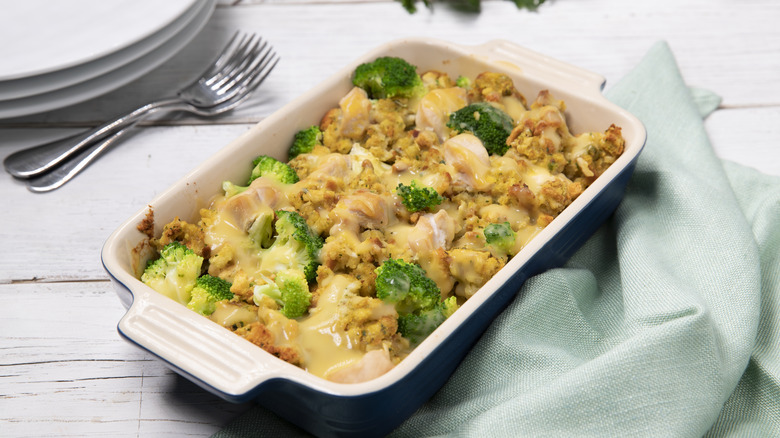16 Casserole Mistakes You Want To Avoid Making, According To A Trained Chef
Casseroles aren't the most demanding of meals. In fact, they're among the simplest ways to feed a family or a large crowd. From classics like tuna or green bean casserole to lasagna, many novice cooks can count a casserole among the first recipes they master. And they're equally useful for a skilled cook who just wants to get a no-fuss meal on the table.
Still, while they're simple in theory, there are plenty of ways your casserole can turn out to be less than ideal. As a trained chef and former restaurateur, and more importantly as a seasoned home cook who raised a family on a tight budget, I have decades of casserole-making experience to draw upon. These are some of the most common mistakes I've seen (or made) over the years. Knowing how they can sabotage your efforts and learning how to avoid them will make your life — and dinner preparation — a lot easier.
1. Not using the right shape or size of casserole dish
Most casserole recipes explicitly tell you which baking dish to use, both size and shape. That's mostly so you'll know the dish is big enough to hold the recipe as written, without overfilling and making a mess. There are other less-obvious reasons, as well. Some recipes require a deep casserole dish, because of slow-cooking ingredients that will need more time in the oven. Others may call for a broader, shallower dish so they'll cook more quickly or give you a casserole with a high ratio of crunchy or cheesy topping.
That doesn't mean you can't change things to suit yourself. You can par-cook the ingredients first to reduce oven time and get dinner on the table sooner. And if you're worried about your casserole bubbling over and making a mess in your oven, just slide a sheet pan under it to catch any drips (pro tip: line it first with foil or parchment for easy cleanup).
2. Opting for a metal pan as your dish
You may not have a lot of casserole dishes, because they're bulky and heavy. That means possibly not having the right size for a given recipe and facing the temptation to use a metal pan instead.
We won't say that you can't ever do it, but there are reasons why you shouldn't bake a casserole in a metal pan. The most important is that casserole dishes are slow to conduct heat in and out, providing gentle cooking for your ingredients and remaining warm long after you take your casserole out of the oven. Metal pans heat up quickly and cool down quickly, which can result in casseroles with overdone edges and a meal that cools off rapidly while you're setting the table.
Cast iron is an exception here, but a casserole with acidic ingredients like tomato sauce will discolor as it interacts with the iron. The same is true of aluminum pans. Non-stick or stainless pans won't, but you'll run the risk of damaging their finish with your serving utensils. One obvious exception to the no-metal rule is foil pans for potlucks and make-ahead freezer meals; you'll just need to choose casseroles with non-acidic ingredients for those.
3. Using too much sauce (or too little) in your casserole
This one's tough to work around, because you're relying on the recipe writer to get it right. Some casseroles need to have more sauce right from the beginning, to account for evaporation or because their ingredients will absorb liquid as the casserole cooks. Our personal take is that "just enough sauce to barely cover everything" works for most recipes. If you're using the dish your recipe calls for, and the sauce doesn't reach at least this level, you may need to add a bit more. Too much sauce is less of an issue because you can always spoon some from your casserole as it cooks, or just uncover the dish and cook it longer, until the excess evaporates.
When in doubt, err on the side of more sauce rather than less, since it's easier to fix. With tomato-based sauces, you can add tomato juice, crushed tomatoes, or more sauce; for creamy sauces, you can crack another can of soup (or use béchamel sauce or even heavy cream) to stretch your sauce.
4. Letting your vegetables make the dish soggy
Some casseroles use ingredients with a high-water content. These include mushrooms, vegetables like zucchini and eggplant, juicy stems from chard or pak choy, and even onions when they're used in great quantity. Recipes using watery vegetables usually — but don't always — give you instructions for dealing with that extra moisture. Don't skip those steps! You may be told to salt and drain your zucchini before assembling the casserole, for example, or to dry saute mushrooms until they've released their natural juices in the pan.
Frozen vegetables are especially problematic, weeping moisture as they thaw. It's best not to add them directly to your casseroles; instead, you should thaw them under running water, then drain and thoroughly dry them on paper towels. A quick saute in a dry pan can help, too. Vegetables aren't the only cause of watery casseroles, but they're an easy one to fix.
5. Not prepping the vegetables so they'll all cook in the same time
Budding chefs spend a lot of time in culinary school learning how to chop vegetables into uniform dice. That's partly because uniform cuts look more professional, but it's mostly so they'll cook evenly. Casserole recipes that call for (non-frozen) vegetables usually make a point of this, too. Which is great, except that vegetables don't always cook at the same rate. Carrots are denser than potatoes or winter squash, for example. You can get around this by cutting softer vegetables like potatoes into bigger pieces and denser ones like carrots into smaller pieces — but that can spoil the look of the dish. It also means that the finished casserole won't be as balanced from mouthful to mouthful.
We find that the best solution is to cut the vegetables into equal sizes — gaining the benefits of uniformity — and to par-cook the slow-cooking vegetables before adding them to your casserole. That way, they'll all be done at the same time, or nearly enough that none should be overcooked and mushy.
6. Using fully cooked pasta or rice in your casseroles
Most recipes rely on a starchy ingredient — potatoes, noodles, grains — to make the casserole hearty and comforting. Ideally, they'll be perfectly tender when the casserole is done, and not falling apart or mushy. That's sometimes difficult with pasta, or with grains such as rice. The fault lies with recipe writers, who blithely tell you to cook them "according to the package instructions." Unfortunately, your rice or noodles will continue to cook in the casserole's sauce, absorbing moisture and softening. If they're fully cooked when you put your casserole in the oven, a mushy outcome is almost guaranteed.
You're better off cooking your pasta only part-way, perhaps ⅔ of the recommended cooking time for thin shapes and ¾ for thick ones. They'll still finish cooking in your casserole but won't lose their texture. Similarly, cook your grains in less than the usual quantity of water (perhaps 1 ¼ to 1 ½ cups of water per cup of rice, rather than 2), so they'll retain some texture when the casserole is finished.
7. Getting the cheese wrong
When paired properly, cheese and casseroles are a match made in heaven. Cheese does a lot for your finished baked dish, either as a browned and savory topping or when stirred through the entire casserole. Casseroles with too little cheese can lack richness and flavor, while too much can leave them a greasy mess. Ideally, your recipe will get the amount of cheese right, but you may need to make a game-time decision about increasing or decreasing it. A half-cup of cheese in 3 to 4 cups of liquid is the baseline for a cheese sauce, and up to a cup is fine. After that, we find that the risk of the sauce curdling rises sharply. As for a cap on the cheese on top, you need just enough to make a thin continuous layer.
Then there's the question of which cheeses to use. Soft, young cheeses like mozzarella, fontina, cream cheese, and mild or medium cheddar melt beautifully but are mild tasting. Use those for the bulk of your cheese, and then add a punchier flavor with hard grating cheeses like Parmesan or dry Jack.
8. Letting your casserole's sauce curdle
A sauce is said to curdle or break when it loses its smooth texture and turns into nubbins of protein floating in liquid. Your casserole will still be edible, but its flavor and especially its appearance will suffer. Sauces break for a lot of reasons. Dairy-based and egg-thickened sauces are the worst offenders, especially if your oven's too hot or you bake it longer to cook down extra sauce. Turning down the heat and spooning out excess sauce instead can help you avoid this problem.
Sauces based on a canned soup, cream cheese, or heavy cream are usually safe; those all have stabilizers to help keep them from curdling, and the cream's high-fat content gives you some protection, as well. Starches such as flour and cornstarch can help stabilize the sauce, binding up the liquids so they can't separate. Less-obvious binder ingredients include instant mashed potato flakes and even powdered coffee creamer.
9. Forgetting to check (or tweak) the seasonings
Casseroles are sometimes just meh: not bad, necessarily, but they definitely need something extra. That's because recipes are often made deliberately safe to appeal to the widest possible audience. Here's a professional's tip: when trying a new recipe, spoon some sauce into a small cup and microwave it until it thickens. Now taste it and ask yourself what it needs. Those beginning canned soups or powdered mixes won't lack salt, but they may need other flavors. Most of the casserole's ingredients will be neutral, so the sauce on its own should taste slightly over-seasoned.
Add salt if you need it, but don't stop there. Crank things up with spices or dried herbs, or use umami-rich ingredients like crumbled nori or Worcestershire sauce for an added kick. For casseroles with creamy sauces, a mild hint of acidity from buttermilk or Worcestershire sauce will also help lighten and brighten the dish's flavors.
10. Not cooking to the correct internal temperature
Most casserole recipes are vague about doneness. "Until the sauce is bubbly and the top is golden," is as good as it usually gets. That's fine, but it falls short of any reasonable standard for food safety. Official guidance is more definite. The USDA recommends cooking casseroles to 165 F, the same as poultry or leftovers. There are a lot of reasons for this. One is that casseroles typically include high-risk ingredients like eggs, dairy, and meats. They also often combine cooked and uncooked ingredients, which risks the uncooked ingredients passing pathogens to the cooked ones. Cooking to 165 degrees also provides a margin of safety in case any ingredients were kept too long at room temperature and are potentially breeding bacteria.
Eyeballing your casserole isn't good enough. The best way to check its temperature, and to make sure it's food safe, is with a good instant-read thermometer.
11. Burning the top of your casserole
Your favorite casserole recipe almost certainly includes a golden topping. It may be made of crumbs or cheese, but it'll be there. In the case of cheese specifically, some of us may go slightly beyond golden because we like the browned, crispy edges.
But sometimes, the casserole is just plain burnt on top, which is nobody's idea of a good time. There are several reasons casseroles can burn on top, including an ill-timed phone call or kid emergency to distract you at the crucial moment — but a few common mistakes are usually responsible. One is uncovering your casserole earlier than you should, or not covering it at all. Foil slows browning until your casserole is nearly done, when you can uncover it long enough for that perfect golden finish. You may also have baked it too hot (your oven's built-in thermostat is unreliable) or on a top rack. Your lower rack is the best bet for casseroles.
If your casserole is already over-baked, you can try scraping off burnt crumbs and replacing them with crumbs toasted in a skillet. Scorched cheese can be masked (if it's not too bad) by melting a fresh handful of cheese over it.
12. Forgetting to rest the casserole
No matter how hungry you and your family are, it's not usually a good idea to tuck into your casserole the moment it comes out of the oven. Casserole dishes are heavy precisely so they'll retain heat, and a few minutes' rest after they come out isn't an afterthought — it's an integral part of the cooking process. Your food's temperature will continue to rise after you take it out of the oven (that's why you rest a roast or your holiday bird after it's removed). And it's factored into many of the USDA's cooking temperature recommendations.
It's not just about food safety, though. Giving your casserole at least 10 to 20 minutes after coming out of the oven allows the starches to cool and firm up, and for the sauce to thicken to its final consistency. Your portions will hold together better when they're served, and the improved texture after sitting will make it more pleasant to eat. Also, giving it time to cool a bit — still hot, but not super hot — means your palate can experience the flavors fully without searing your taste buds.
13. Skipping the textural contrasts in the dish
One common casserole mistake, especially when you're winging it, is missing out on a textural contrast. Many of us default to a cheese topping, but other options will still give you that golden look and also lend some textural contrast in the form of crunchiness. Breadcrumbs are an obvious choice, but alternatives include croutons, crushed potato chips or tortilla chips, crumbled cornflakes or other cereals, and cracker crumbs. Nuts and seeds are iffy, because they burn easily, but those can be stirred into the body of the casserole instead. If you can't do without your layer of cheese, that's fine too. Crumbs or croutons play nicely with cheese — and in fact, that's how our grandmother topped her mac & cheese.
You might also bring a textural contrast to your casserole after it's cooked by topping each portion with crunchy garnishes like seeds, nuts, or croutons. The combination of dry croutons and a creamy casserole can provide the same intriguing contrast that makes bread-based salads like fattoush popular.
14. Not planning ahead for multiple meals
Casseroles are the quintessential group meal, whether it's a family dinner or a potluck. But what if you're cooking just for yourself or for two? Does that mean casseroles are out of the picture? Of course not — casseroles are adaptable. You could scale your recipe down, make a full-sized casserole and divide it into meal-sized portions, or divide a full recipe into pans for cooking later. Scaling your recipe is arguably inefficient; you'll do very nearly the same amount of work, but only have one meal to show for your effort.
Baking a full-sized casserole and portioning it is a low-effort alternative. Simply let the casserole cool, divide it into air-tight containers, and freeze them (leave off crunchy or cheesy toppings, and add those when you reheat your meals). To split your recipe into single portions for later cooking, divide the ingredients between foil pans, ramekins, or individual gratin dishes. Wrap them tightly with plastic wrap, or freeze them and then vacuum-seal them, and they'll keep for months. Just remember to label and date them, so you'll know what you've got and how long it's been there.
15. Leaving out healthy casserole substitutions
Casseroles are convenient by nature, but they aren't always the healthiest mealtime option. Often, their convenience and flavor come from heavily processed, high-sodium convenience foods or a welter of ingredients — like cheese, cream, and processed meats — that are loaded with saturated fat. You can dial the balance back toward healthfulness with a handful of smart substitutions. Buttermilk adds a cheesy tang but little fat, while nutritional yeast has none (and it's a vegan's friend for its funky kick of umami). Either helps you use less cheese without losing flavor — a clear win on the reduced-fat front.
Other casserole staples also suggest easy substitutions. Swapping canned cream soup for homemade béchamel or Greek yogurt, shredding fresh potatoes instead of using prepared hash browns (which often have oil and salt added), and using whole grains rather than white rice, can all up your nutritional value. You can also add nutrition in the form of extra vegetables. Frozen spinach is a great option, because it can work with either creamy or tomato-based sauces equally well.
16. Not browning and draining the meats for your casserole
This step isn't always practical when you're building a casserole around leftover meat from a previous meal, but if you're starting from raw meat — or especially ground meat — it's an essential step. One obvious reason for this is simply that browning the meat for your casserole adds flavor, full stop. Chemical changes called Maillard reactions break down amino acids and sugars in meats when they're heated, causing browning but also recombining them into complex molecules that appeal to our taste buds. Another reason for browning your meats before putting them in the casserole is that it cooks out some of the juices (which might otherwise make your casserole soggy) as well as rendering their fat.
That leads us to one final benefit of browning your meats, which is the opportunity to drain away that excess fat before adding the meat to your casserole. It keeps your casseroles from being greasy and heavy, and it cuts the calories per portion without taking away any of the ingredients and flavors you actually love.
